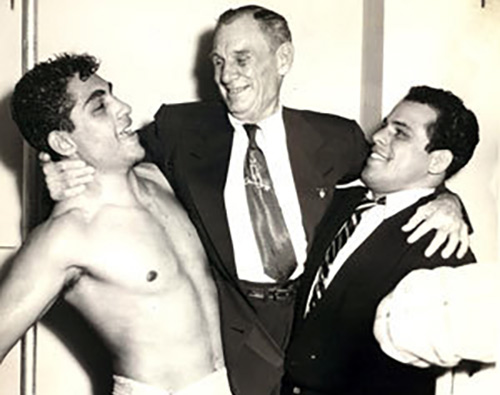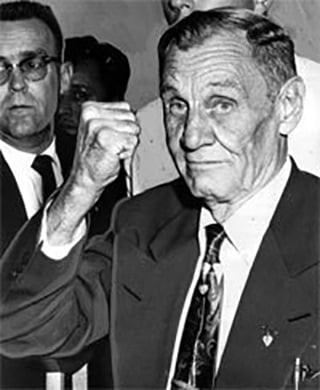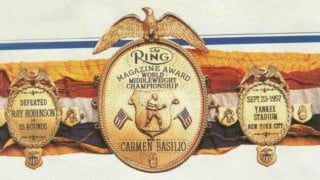Boxing Hall of Fame: Whitey Esneault, the unknown trainer

CANASTOTA, N.Y. – On March 4, 1921, the United States Congress approved the burial of an unidentified American solider from World War I in the plaza of the new Memorial Ampitheater in Arlington, Va. Within the white marble sarcophagus, forever memorialized as the Tomb of the Unknown Soldier, lie the remains of a fighting man whose name is known only to God. The honored deceased stands sentinel atop a hill overlooking Washington, D.C.
The final resting place of one of boxing’s most overlooked and underappreciated trainers is not unknown, nor is the occupant of the grave unidentified. Ernest “Whitey” Esneault, a Navy veteran of World War I, was 76 when he died of a lung infection on Jan. 20, 1968, in his hometown of New Orleans. As one of the local sports writers noted at the time, “when Whitey Esneault died, the Golden Age of boxing in New Orleans was laid to rest in St. Roch No. 2 cemetery.”
 Esneault – who developed one inductee into the International Boxing Hall of Fame, former light heavyweight champion Willie Pastrano (Class of 2001) as well as former world titlists Ralph Dupas and Freddie Little and such notable contenders as Tony Licata and brothers Bernard and Maxie Docusen – will receive his long-delayed certification as one of the great teachers of the pugilistic arts when he is inducted into the IBHOF here on Sunday, in the Non-Participant category.
Esneault – who developed one inductee into the International Boxing Hall of Fame, former light heavyweight champion Willie Pastrano (Class of 2001) as well as former world titlists Ralph Dupas and Freddie Little and such notable contenders as Tony Licata and brothers Bernard and Maxie Docusen – will receive his long-delayed certification as one of the great teachers of the pugilistic arts when he is inducted into the IBHOF here on Sunday, in the Non-Participant category.
But Esneault’s moment of glory again raises the age-old question of whether a falling tree in a stand of virgin timber makes a sound if there is no one around to hear it. When “Mr. Whitey,” as he was affectionately known to youngsters who learned boxing, and so much more, for 50-plus years at St. Mary’s Italian Gym in the French Quarter, was inducted into the Greater New Orleans Sports Hall of Fame in 2006, no member of his family was on hand to speak on his behalf because none could be located.
And so it again will be on Sunday. Despite the best efforts of the IBHOF, Esneault, gone 48 years, will be enshrined without anyone from his family in attendance, if indeed such a person is still alive. Nor will any of his finest students be present to mention what a profound influence he had on their professional and personal lives; they, too, are deceased or too elderly and infirm to travel.
But Esneault, who emphasized speed and footwork to his many charges, nonetheless deserves to have his plaque hung on the hallowed walls of the IBHOF because  well, just because.
“If Whitey had been at Stillman’s Gym or Gleason’s Gym in New York, turning out fighters like the Docusens, Dupas and Pastrano, he’d already be in the Hall of Fame,” the late, great Angelo Dundee, who assumed the training duties of fully developed future champs Pastrano and Dupas from Esneault, said in 2006. There’s no doubt in my mind about that.”
So why didn’t Esneault take his finest fighters, and himself for that matter, to places where the lights shone brighter and lasting fame is easier to take root? He was always reluctant to stray far from his home base of New Orleans, and even more so after a lifelong struggle with diabetes cost him his left leg in 1954. The loss of his leg eventually led to ongoing battles with depression and alcoholism.
Through it all, those who knew and loved him were adamant in their belief that Whitey Esneault was not only a great trainer, but a great human being.
“Mr. Whitey’s a wonderful man,” Pastrano, who was 61 when he died in 1997, said some 50-plus years ago. “He’ll do anything in the world for you. He gives as much time and consideration to the little kids as he does to his professionals. After his amateurs fight he always takes them out and feeds them – out of his own pocket. Everybody likes him except the guys who are jealous of him.”
GONE MUCH LONGER THAN 60 SECONDS
Gone in 60 Seconds is a 2000 movie (and a remake of a 1974 film of the same name) starring Nicolas Cage as a skilled, fast-working thief of very expensive, high-performance cars.
It also could be the title of the real-life “Crime of the Century,” as least as it pertains to Canastota, a bucolic village of a 4,000 boxing-loving souls nestled along the banks of the Erie Canal just off Exit 34 of the New York Thruway.

The belt won by Carmen Basilio in his 1957 victory over Ray Robinson.
Under the cloak of darkness the night of Nov. 5, 2015 (two days before what would have been the 88th birthday of Basilio, who died in 2012), burglars, who obviously knew what they were doing and what they wanted, broke through a window at the International Boxing Hall of Fame and made off with six world championship belts, four of which were earned in the ring by Canastota’s favorite son, former welterweight and middleweight champion Carmen Basilio, the other two donated to the IBHOF by former middleweight champion Tony Zale. The thieves were in and out within 60 seconds, and despite a quick response time by the Canastota police, who arrived at the crime scene inside of five minutes, the treasured artifacts and the perpetrators were nowhere to be found. The treasured items are still missing, despite the best efforts of local law enforcement and the antiquities division of the Federal Bureau of Investigation, which typically is deployed on high-profile art theft cases.
Basilio, known as the “Upstate Onion Farmer,” earned his belts from 1953 to ’57 with victories against Billy Graham, Sugar Ray Robinson, Johnny Saxton and Tony DeMarco.
In purely monetary terms, the stolen items are relatively inexpensive – Zale’s belts were appraised at $2,500 apiece when they were donated to the IBHOF in 1998 – but Canastota police chief James Zophy said they were “priceless” because they were “beyond replication” and of such immeasurable sentimental value to the boxing world in general and to Canastota in particular.
This will be the first IBHOF induction weekend since the items were stolen, and their absence figures to cast a pall over the festivities, as will the June 3 death of “The Greatest,” Muhammad Ali, a charter inductee into the Hall of Fame in 1990, as was Basilio. (Zale, a native of Gary, Ind., was inducted in 1991.)














